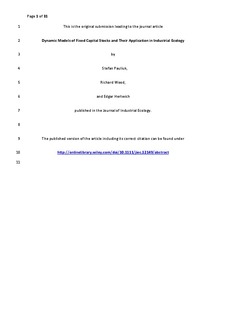| dc.contributor.author | Pauliuk, Stefan | |
| dc.contributor.author | Wood, Richard | |
| dc.contributor.author | Hertwich, Edgar G. | |
| dc.date.accessioned | 2014-06-24T06:44:10Z | |
| dc.date.accessioned | 2016-06-15T12:17:30Z | |
| dc.date.available | 2014-06-24T06:44:10Z | |
| dc.date.available | 2016-06-15T12:17:30Z | |
| dc.date.issued | 2014 | |
| dc.identifier.citation | Journal of Industrial Ecology 2014 | nb_NO |
| dc.identifier.issn | 1088-1980 | |
| dc.identifier.uri | http://hdl.handle.net/11250/2392707 | |
| dc.description.abstract | Industrial assets or fixed capital stocks are at the core of the transition to a low-carbon economy. They represent substantial accumulations of capital, bulk materials, and critical metals. Their lifetime determines the potential for material recycling and how fast they can be replaced by new, more efficient facilities. Their efficiency determines the coupling between useful output and energy and material throughput. A sound understanding of the economic and physical properties of fixed capital stocks is essential to anticipating the long-term environmental and economic consequences of the new energy future. We identify substantial overlap in the way stocks are modeled in national accounting, dynamic material flow analysis, dynamic input-output (I/O) analysis, and life cycle assessment (LCA) and we merge these concepts into a common framework for modeling fixed capital stocks. We demonstrate the usefulness of the framework for simultaneous accounting of capital and material stocks and for consequential LCA. We apply the framework to design a demand-driven dynamic I/O model with dynamic capital stocks, and we synthesize both the marginal and attributional matrix of technical coefficients (A-matrix) from detailed process inventories of fixed assets of different age cohorts and technologies. The stock modeling framework allows researchers to identify and exploit synergies between different model families under the umbrella of socioeconomic metabolism. | nb_NO |
| dc.language.iso | eng | nb_NO |
| dc.publisher | Wiley | nb_NO |
| dc.subject | consequential LCA; dynamic input-output analysis; dynamic stock model; industrial metabolism; material flow analysis (MFA); perpetual inventory method | nb_NO |
| dc.title | Dynamic Models of Fixed Capital Stocks and Their Application in Industrial Ecology | nb_NO |
| dc.type | Journal article | nb_NO |
| dc.type | Peer reviewed | nb_NO |
| dc.date.updated | 2014-06-24T06:44:11Z | |
| dc.source.volume | 19 | nb_NO |
| dc.source.journal | Journal of Industrial Ecology | nb_NO |
| dc.source.issue | 1 | nb_NO |
| dc.identifier.doi | 10.1111/jiec.12149 | |
| dc.identifier.cristin | 1140188 | |
| dc.description.localcode | This is the pre-peer reviewed version of the following article: [FULL CITE], which has been published in final form at DOI: 10.1111/jiec.12149. This article may be used for non-commercial purposes in accordance with Wiley Terms and Conditions for Self-Archiving. | nb_NO |
